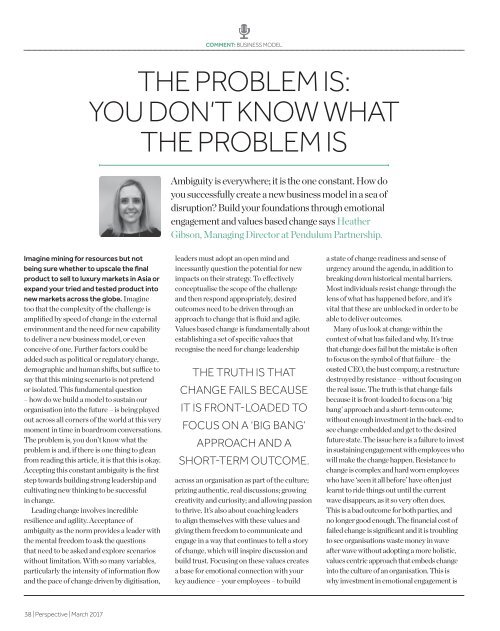EP Perspective March 2017
Create successful ePaper yourself
Turn your PDF publications into a flip-book with our unique Google optimized e-Paper software.
COMMENT: BUSINESS MODEL<br />
THE PROBLEM IS:<br />
YOU DON’T KNOW WHAT<br />
THE PROBLEM IS<br />
Ambiguity is everywhere; it is the one constant. How do<br />
you successfully create a new business model in a sea of<br />
disruption? Build your foundations through emotional<br />
engagement and values based change says Heather<br />
Gibson, Managing Director at Pendulum Partnership.<br />
Imagine mining for resources but not<br />
being sure whether to upscale the final<br />
product to sell to luxury markets in Asia or<br />
expand your tried and tested product into<br />
new markets across the globe. Imagine<br />
too that the complexity of the challenge is<br />
amplified by speed of change in the external<br />
environment and the need for new capability<br />
to deliver a new business model, or even<br />
conceive of one. Further factors could be<br />
added such as political or regulatory change,<br />
demographic and human shifts, but suffice to<br />
say that this mining scenario is not pretend<br />
or isolated. This fundamental question<br />
– how do we build a model to sustain our<br />
organisation into the future – is being played<br />
out across all corners of the world at this very<br />
moment in time in boardroom conversations.<br />
The problem is, you don’t know what the<br />
problem is and, if there is one thing to glean<br />
from reading this article, it is that this is okay.<br />
Accepting this constant ambiguity is the first<br />
step towards building strong leadership and<br />
cultivating new thinking to be successful<br />
in change.<br />
Leading change involves incredible<br />
resilience and agility. Acceptance of<br />
ambiguity as the norm provides a leader with<br />
the mental freedom to ask the questions<br />
that need to be asked and explore scenarios<br />
without limitation. With so many variables,<br />
particularly the intensity of information flow<br />
and the pace of change driven by digitisation,<br />
leaders must adopt an open mind and<br />
incessantly question the potential for new<br />
impacts on their strategy. To effectively<br />
conceptualise the scope of the challenge<br />
and then respond appropriately, desired<br />
outcomes need to be driven through an<br />
approach to change that is fluid and agile.<br />
Values based change is fundamentally about<br />
establishing a set of specific values that<br />
recognise the need for change leadership<br />
THE TRUTH IS THAT<br />
CHANGE FAILS BECAUSE<br />
IT IS FRONT-LOADED TO<br />
FOCUS ON A ‘BIG BANG’<br />
APPROACH AND A<br />
SHORT-TERM OUTCOME.<br />
across an organisation as part of the culture;<br />
prizing authentic, real discussions; growing<br />
creativity and curiosity; and allowing passion<br />
to thrive. It’s also about coaching leaders<br />
to align themselves with these values and<br />
giving them freedom to communicate and<br />
engage in a way that continues to tell a story<br />
of change, which will inspire discussion and<br />
build trust. Focusing on these values creates<br />
a base for emotional connection with your<br />
key audience – your employees – to build<br />
a state of change readiness and sense of<br />
urgency around the agenda, in addition to<br />
breaking down historical mental barriers.<br />
Most individuals resist change through the<br />
lens of what has happened before, and it’s<br />
vital that these are unblocked in order to be<br />
able to deliver outcomes.<br />
Many of us look at change within the<br />
context of what has failed and why. It’s true<br />
that change does fail but the mistake is often<br />
to focus on the symbol of that failure – the<br />
ousted CEO, the bust company, a restructure<br />
destroyed by resistance – without focusing on<br />
the real issue. The truth is that change fails<br />
because it is front-loaded to focus on a ‘big<br />
bang’ approach and a short-term outcome,<br />
without enough investment in the back-end to<br />
see change embedded and get to the desired<br />
future state. The issue here is a failure to invest<br />
in sustaining engagement with employees who<br />
will make the change happen. Resistance to<br />
change is complex and hard worn employees<br />
who have ‘seen it all before’ have often just<br />
learnt to ride things out until the current<br />
wave disappears, as it so very often does.<br />
This is a bad outcome for both parties, and<br />
no longer good enough. The financial cost of<br />
failed change is significant and it is troubling<br />
to see organisations waste money in wave<br />
after wave without adopting a more holistic,<br />
values centric approach that embeds change<br />
into the culture of an organisation. This is<br />
why investment in emotional engagement is<br />
CONVISUM | 123RF.COM<br />
38 | <strong>Perspective</strong> | <strong>March</strong> <strong>2017</strong>
















